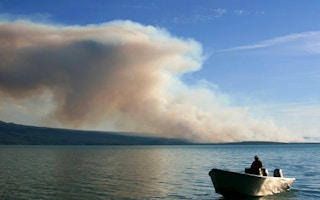In a warming world, forest fires could be about to put more carbon dioxide into the atmosphere than the trees absorb.
New research by US scientists looked at decades of wildfire incidence in Alaska, and they have found that at least one region is now a net exporter of carbon.
This is a reversal of the normal arrangements, whereby trees photosynthesise tissue from the carbon dioxide in the atmosphere. As they absorb carbon, they sequester it in roots, timber and leaves, and then in leaf litter in the forest soils.
Fire is a natural hazard, and some geographical zones –the Mediterranean, the US southwest, and Australia – are adapted to periodic fire.
But as the planet warms, there have been increasing levels of fire even in the rainforests of the Amazon and in the boreal forests of the near-Arctic.
Charcoal fragments
The Arctic and sub-Arctic forests contain almost one-third of the planet’s store of terrestrial carbon. And the news could send climate scientists who are trying to model the changes in the carbon cycle back to their computer simulations.
Alaska’s official record of forest fire dates back only to 1939. So Ryan Kelly and Feng Sheng Hu, of the University of Illinois Urbana and colleagues looked at charcoal fragments in the lake sediments of the Yukon Flats area of Alaska to build up a picture of the pattern of fires and model the history of the last 10,000 years.
They report in Nature Climate Change that they found that fire frequency in one 2,000 kilometre band of the forest is higher now than at any time in the last 100 centuries.
It follows that global warming – as a consequence of the release of the greenhouse gas carbon dioxide from the prodigal combustion of fossil fuels by humankind – is making the forests more vulnerable. And, in turn, the forests may be releasing more CO2, thus fuelling more global warming.
The recent outbreaks of fire in Alaska are calculated to have put about 12 per cent of the region’s stored carbon back into the atmosphere during the last 50 years.
“Most studies of carbon cycling in the boreal forests have been motivated by the fact that there’s just an enormous amount of carbon in these high latitude ecosystems,” Professor Hu says.
“Up to 30 per cent of the Earth’s terrestrial carbon is in that system. And, simultaneously, this region is warming up faster than any other parts of the world.”
Brake on climate change
Ecosystems adapt to change: there had been a rule-of-thumb assumption that as the Arctic warmed, forests would expand further north to absorb more of the newly-available carbon, and serve as a brake on climate change. This may not be the case.
The research paper puts the message with more than usual clarity. Predictions that terrestrial carbon sinks of northern high latitudes will mitigate rising atmospheric CO2 “may be over-optimistic”, the authors conclude.
“The effects of forest fires on the carbon cycle are very dramatic,” Professor Hu says. “Fires explain about 80 per cent of the change in carbon storage over the past millennium, and a large amount of carbon has been lost from this ecosystem because of increasing forest fires.
“This area has burned more than any other place in the boreal forests of North America. We chose the area for this study because we thought it could be an early indicator of the future.”










